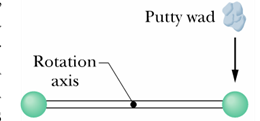Two balls are attached to the ends of a thin rod of length role="math" localid="1661007264498" and negligible mass. The rod is free to rotate in a vertical plane without friction about a horizontal axis through its center. With the rod initially horizontal (In Figure), wad of wet putty drops onto one of the balls, hitting it with a speed of and then sticking to it.
(a) What is the angular speed of the system just after the putty wad hits?
(b) What is the ratio of the kinetic energy of the system after the collision to that of the putty wad just before?
(c) Through what angle will the system rotate before it momentarily stops?






